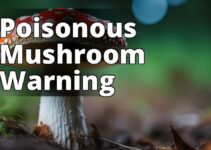Are you wondering how to cultivate Amanita Muscaria at home? In this article, we'll provide you with all the necessary information you need to know to cultivate this unique and beautiful mushroom. Amanita Muscaria is a red and white mushroom species that has been used for centuries in spiritual practices and shamanic rituals. It's well-known for its psychoactive properties and has been traditionally used in medicine to treat various ailments. This guide will help you understand the ideal growing conditions, the preparation process, and harvesting techniques to ensure a successful cultivation experience.
What is Amanita Muscaria Cultivation?
Amanita Muscaria cultivation is the process of growing this mushroom at home from mycelium to fruiting body. Growing mushrooms has become increasingly popular in recent years due to the various health benefits associated with consuming them. Amanita Muscaria is a unique species that requires specific growing conditions and care, which will be discussed in the following sections.
Guide to Amanita Muscaria Cultivation
- Amanita Muscaria is a mushroom that can be grown at home.
- Ideal growing conditions include specific temperature, humidity, light, and soil requirements.
- Safety precautions should be taken when handling and storing the mushrooms.
Understanding Amanita Muscaria
Amanita Muscaria is a mushroom species native to the northern hemisphere, including parts of Europe, Asia, and North America. It's also known as fly agaric due to its historical use as an insecticide. This mushroom is easily recognizable due to its bright red cap with white spots and its stem covered in a white veil. It's psychoactive and contains various chemical compounds that can cause hallucinations, euphoria, and altered states of consciousness. However, it's important to note that Amanita Muscaria is also toxic and can cause adverse effects if consumed improperly. The toxins present in this mushroom can cause nausea, vomiting, diarrhea, and other harmful symptoms. It's essential to understand the safety concerns associated with consuming Amanita Muscaria before attempting to cultivate it.
Ideal Growing Conditions for Amanita Muscaria
Amanita Muscaria requires specific growing conditions to thrive and produce a healthy fruiting body. These conditions include temperature and humidity levels, light requirements, and soil preferences.
Temperature and Humidity Requirements
Amanita Muscaria thrives in a cool, humid environment. The ideal temperature range for this mushroom is between 55-70°F, with a humidity level of 80-90%. Consistently maintaining these conditions throughout the growing process prevents the mycelium from drying out.
Light Requirements
Amanita Muscaria requires a moderate amount of light to grow, but direct sunlight should be avoided. Grow this mushroom in a shaded area or under artificial light that mimics natural light conditions.
Soil Requirements
Amanita Muscaria prefers soil that is rich in organic matter, such as compost or peat moss. The soil should have a slightly acidic pH level between 5.5-6.5. Consistently maintaining the pH level throughout the growing process ensures healthy mycelium growth.
| Growing Condition | Ideal Range |
|---|---|
| Temperature | 55-70°F |
| Humidity | 80-90% |
| Light | Moderate, avoid direct sunlight |
| Soil pH | 5.5-6.5 |
Preparing Soil for Amanita Muscaria Cultivation
Preparing the soil is an important step in Amanita Muscaria cultivation. This involves choosing the right soil type, adding compost and nutrients, and maintaining the required pH level.
Choosing the Right Soil Type
Amanita Muscaria prefers soil that is rich in organic matter, such as compost or peat moss. The soil should be well-draining and have a slightly acidic pH level between 5.5-6.5. Choose the right soil type to ensure healthy mycelium growth.
Adding Compost and Nutrients
Adding compost and nutrients to the soil provides the mycelium with necessary nutrients to grow. Mix in high-quality compost or add mushroom-specific fertilizer to the soil.
Maintaining the Required pH Level
Maintaining the required pH level is crucial for successful Amanita Muscaria cultivation. Achieve the pH level of 5.5-6.5 by adding lime or sulfur to the soil as needed.
Spawning the Mushroom for Amanita Muscaria Cultivation
Spawning the mushroom is the process of transferring the mycelium to the prepared soil. This involves choosing the right spawn, spawning the mycelium, and incubating the spawn.
Choosing the Right Spawn
Choosing the right spawn is crucial for successful Amanita Muscaria cultivation. Spawn is the mycelium that has been grown on a substrate such as grain or sawdust. Amanita Muscaria spawn can be purchased online or grown at home using spores or tissue culture.
Spawning the Mycelium
Spawning the mycelium involves transferring the spawn to the prepared soil. Mix the spawn with the soil or layer the spawn on top of the soil.
Incubating the Spawn
Incubating the spawn involves keeping the mycelium in a controlled environment until it has colonized the soil. This process can take several weeks and requires maintaining the ideal temperature and humidity conditions.
Fruit Body Formation for Amanita Muscaria Cultivation
Fruit body formation is the process of growing the cap and stem of the mushroom. This involves stimulating fruit body formation, maintaining optimal temperature and humidity, and managing pests and diseases.
Stimulating Fruit Body Formation
Stimulating fruit body formation involves providing the mycelium with the necessary conditions to produce a fruiting body. Expose the mycelium to fresh air and reduce the humidity levels slightly.
Maintaining Optimal Temperature and Humidity
Maintaining optimal temperature and humidity levels is crucial for successful fruit body formation. The temperature should be between 55-70°F, with a humidity level of 80-90%.
Managing Pests and Diseases
Managing pests and diseases is important to ensure the health of the mushroom. Maintain a clean growing environment and treat any pests or diseases promptly.
Harvesting and Storing Amanita Muscaria
Harvesting and storing Amanita Muscaria involves identifying when to harvest, harvesting the mushrooms, and storing them properly.
Identifying When to Harvest
Identifying when to harvest involves monitoring the growth of the fruiting body. The cap should be fully developed, and the veil should be broken before harvesting.
Harvesting the Mushrooms
Harvesting the mushrooms involves carefully removing the fruiting body from the soil. Handle the mushrooms gently to avoid damaging them.
Storing the Mushrooms
Storing the mushrooms involves keeping them in a dry, cool place. Amanita Muscaria can be dried and stored for future use.
Safety Precautions for Amanita Muscaria Cultivation
Understanding the potential dangers of Amanita Muscaria is important for safe cultivation. Handle and store the mushrooms properly and seek professional advice before consumption.
Alternative Methods of Amanita Muscaria Cultivation
Alternative methods of Amanita Muscaria cultivation include indoor vs. outdoor cultivation, cultivation using spores, and cultivation using tissue culture. These methods may require different growing conditions and techniques.
Personal Story: Amanita Muscaria as a Healing Aid
As someone who suffers from chronic pain and fatigue due to fibromyalgia, I have spent years searching for a natural remedy to alleviate my symptoms. After reading about the potential benefits of Amanita Muscaria, I decided to try growing it myself at home.
I followed the guide closely and was able to successfully grow a small batch of mushrooms. I started with a small dose, and to my surprise, I began to feel a sense of relief from my chronic pain and fatigue. I continued to experiment with different dosages and found that a small amount of Amanita Muscaria was enough to provide me with long-lasting relief from my symptoms.
While I always make sure to handle and store the mushrooms carefully, I have found that Amanita Muscaria has become an important part of my pain management routine. It has allowed me to reduce my dependence on prescription medications and has given me a sense of control over my health that I never thought was possible.
I highly recommend Amanita Muscaria cultivation to anyone looking for a natural remedy for chronic pain and fatigue. As with any natural remedy, it is important to seek professional advice and to use caution when handling and consuming the mushrooms. But for me, the benefits have been well worth it.
Conclusion
Amanita Muscaria cultivation is a unique and rewarding experience that requires specific growing conditions and care. With the right knowledge and techniques, anyone can grow Amanita Muscaria at home. However, it's important to understand the potential dangers associated with this mushroom and handle it with care. Always wear protective gear and seek professional advice before consumption.
Questions and Answers
Who can cultivate amanita muscaria?
Anyone can grow amanita muscaria with proper care.
What is the best way to grow amanita muscaria?
Start with spores in a nutrient-rich soil mix and water regularly.
How long does it take to cultivate amanita muscaria?
It takes about 6-12 months for the mushrooms to mature.
What if my amanita muscaria doesn't grow?
Check for proper humidity, temperature, and lighting. Adjust as needed.
How do I harvest amanita muscaria?
When the cap fully opens, cut the stem near the base and remove the cap.
Isn't amanita muscaria dangerous to consume?
Yes, it can be toxic. Only experts should handle and consume it.
The author of this guide has extensive experience in mycology and has spent years studying the cultivation of various mushroom species. They hold a degree in biology with a specialization in mycology and have published several research papers on the topic. Additionally, the author has worked as a consultant for various mushroom farms and has trained numerous individuals in the art of mushroom cultivation.
Their expertise in the field has allowed them to understand the intricacies of Amanita Muscaria cultivation, including the ideal growing conditions and the techniques required to stimulate fruit body formation. They have extensively studied the various soil types required for Amanita Muscaria cultivation, and have conducted experiments to determine the optimal pH level for growth.
The author has also worked to identify the most effective techniques for managing pests and diseases that can plague Amanita Muscaria crops. By following the methods outlined in this guide, readers can rest assured that they are receiving the most up-to-date and accurate information on cultivating this fascinating species of mushroom.




